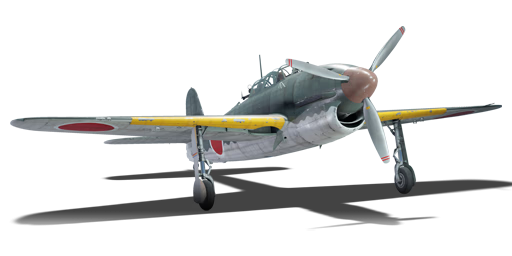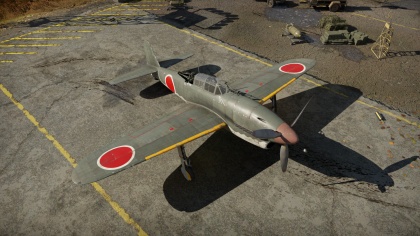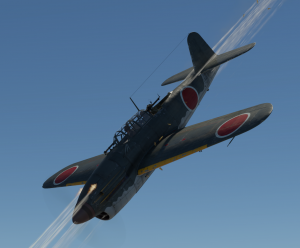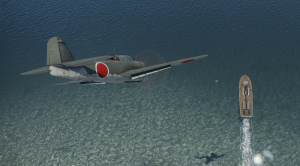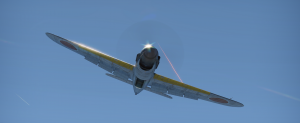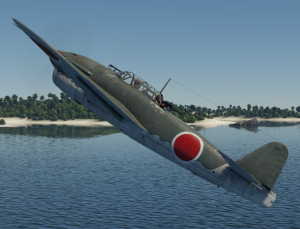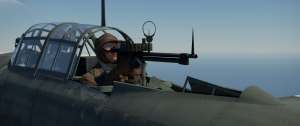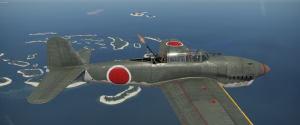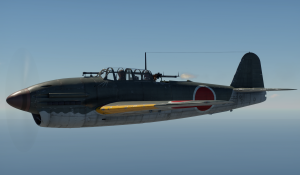D4Y1
Contents
| This page is about the Japanese dive bomber D4Y1. For other versions, see D4Y2 and D4Y3 Ko. |
Description
The D4Y1 Suisei (Comet), nicknamed Judy by the Americans, is a rank II Japanese bomber
with a battle rating of 2.0 (AB/RB) and 2.3 (SB). It was introduced in Update 1.75 "La Résistance". It is a very strong ground attack aircraft, and thanks to its high speed and agility, it can make a great fighter. This is your typical Japanese dive bomber, which has excellent ground pounding capabilities, as well as fighter hunting abilities. All these gifts come with downsides, as the D4Y1 is unable to carry rockets or torpedoes, unlike the D4Y2, and has poor defensive armament compared to the D4Y3. It has an Atsuta Atsuta 21 12-cylinder inline engine, which provides excellent power, but unfortunately has overheating issues.
General info
Flight performance
The D4Y1 is a highly agile and speedy aircraft, it can turn fight anything it wishes, even Spitfires. It gets a bomber airspawn, which allows the D4Y1 to outclimb all the fighters, but be sure to select the right airspawn, because it gets a carrier spawn by default on pacific maps. The only issue with the performance of this aircraft arises at high altitudes, where it is left without a supercharger.
| Characteristics | Max Speed (km/h at 4,750 m) |
Max altitude (metres) |
Turn time (seconds) |
Rate of climb (metres/second) |
Take-off run (metres) | |||
|---|---|---|---|---|---|---|---|---|
| AB | RB | AB | RB | AB | RB | |||
| Stock | 520 | 509 | 9800 | 23.9 | 24.5 | 5.6 | 5.6 | 300 |
| Upgraded | 589 | 552 | 22.2 | 23.0 | 14.4 | 9.3 | ||
Details
| Features | ||||
|---|---|---|---|---|
| Combat flaps | Take-off flaps | Landing flaps | Air brakes | Arrestor gear |
| ✓ | ✓ | ✓ | ✓ | ✓ |
| Limits | ||||||
|---|---|---|---|---|---|---|
| Wings (km/h) | Gear (km/h) | Flaps (km/h) | Max Static G | |||
| Combat | Take-off | Landing | + | - | ||
| 750 | 350 | 480 | 480 | 280 | ~14 | ~10 |
| Optimal velocities (km/h) | |||
|---|---|---|---|
| Ailerons | Rudder | Elevators | Radiator |
| < 350 | < 400 | < 400 | > 200 |
| Compressor (RB/SB) | ||
|---|---|---|
| Setting 1 | ||
| Optimal altitude | 100% Engine power | WEP Engine power |
| 4,500 m | 970 hp | 1,218 hp |
Survivability and armour
The D4Y1 has no armour. Additionally, the fuel tanks are not self-sealing. There are 2 in each wing. The gunner is not covered, making him vulnerable to attacks from the rear.
Armaments
Offensive armament
The D4Y1 is armed with:
- 2 x 7.7 mm Type 97 navy machine guns, nose-mounted (600 rpg = 1,200 total)
Suspended armament
The D4Y1 can be outfitted with the following ordnance:
- Without load
- 1 x 250 kg Navy Type Number 25 Model 2 bomb (250 kg total)
- 1 x 500 kg Number Type 2 50 Model 1 GP(SAP) bomb (500 kg total)
Defensive armament
The D4Y1 is defended by:
- 1 x 7.7 mm Type 92 machine gun, dorsal turret (582 rpg)
Usage in battles
The D4Y1 is an excellent example of a multirole aircraft, as it is an excellent ground attack aircraft, fighter, and bomber. Since you get a bomber airspawn, you can drop your bomb on a base and then start to engage the many fighters below you. You should have no problems engaging them, as long is you keep your speed up and your energy high. One key thing to note is that you don't need to use your defensive turret to shoo away enemy interceptors. You can easily out turn any interceptor at that BR. Besides the fighter role, ground attack is the D4Y1's natural method of play. The 500kg bomb will be excellent for destroying Pillboxes, and you can use your Rifle Caliber machine guns to destroy any soft target you please.Spec
Specific enemies worth noting
- CW-21 - The CW-21 poses a significant threat to the D4Y1, as it can out-turn, out-climb, and outclass the D4Y1 in every conceivable way. Its armament will shred through the D4Y1, and your plane would be a sitting duck. Now, your gunner can be of some use. Since the CW-21 is a very fragile aircraft, your gunner can set it afire, thus giving you the upper hand. But never under any circumstance attempt to go near this plane, as your gunner is only a last resort.
- He 100 D-1 - Much like the CW-21, this aircraft will outclass you in every way. Your turret will once again come in handy, as it will surely damage its cooling system.
Manual Engine Control
| MEC elements | ||||||
|---|---|---|---|---|---|---|
| Mixer | Pitch | Radiator | Supercharger | Turbocharger | ||
| Oil | Water | Type | ||||
| Controllable | Controllable Not auto controlled |
Controllable Not auto controlled |
Controllable Not auto controlled |
Separate | Not controllable 1 gear |
Not controllable |
Modules
| Tier | Flight performance | Survivability | Weaponry | ||
|---|---|---|---|---|---|
| I | Fuselage repair | Radiator | Offensive 7 mm | ||
| II | Compressor | Airframe | New 7 mm MGs | ||
| III | Wings repair | Engine | Turret 7 mm | 13 in (mod35) | |
| IV | Engine injection | Cover | New 7 mm MGs (turret) | ||
The payload option should be a top priority, so getting to tier three modifications is of utmost importance. Rush the new belts and MGs, or the radiator or compressor if you choose to have better performance. Then get the bomb modification. After that, research all engine modifications and then the Survivability Modifications, as well as the repairs. Save the turret for last
Pros and cons
Pros:
- Nimble, can out-turn certain enemy fighters
- Fast for its BR, can outrun anything it wishes, save the CW-21 and He 100
- Its speed forces the enemy to tail behind your gunner, giving you a chance to shoot at the approaching fighter with your turret
- Turret covers all upwards angles and covers a decent part of the rear
- Has an additional 400 than the D4Y2 and D4Y3 Ko rounds in the machine guns, making ammo count less of an issue
- 500 kg bomb will destroy pillboxes, bridges, tanks, and destroyers
- Has Airbrakes
- Armament is nose mounted
Cons:
- The Type 92 gun has a low rate of fire and bad accuracy, which can make it hard to aim if an enemy fighter comes your way
- Significant delay in bomb drop
- Exposed gunner
- Not good for bombing bases
- Offensive armament does not provide enough firepower to down bombers, but it can still work wonders on the many fighters you will face, namely the F2A, I-15/16, and Hurricanes
- Fragile, no armour
- Engine overheats easily, it isn't a traditional Japanese radial engine
- No torpedoes
History
Nicknamed the the "Judy" by allied pilots, the D4Y1 at the beginning of the war was one the fastest planes in all of the Pacific.
The D4Y1 was a carrier based dive bomber, powered by a 1,200 hp "Aichi AE1A Atsuta V12" engine. The D4Y1 was modeled after the German He 118 with the engine being modeled after the DB 601 which was used in the Bf 110. Due to the Japanese Navy requiring an extreme range for the aircraft, it was designed without any armour or self-sealing fuel tanks to lighten the plane so it would use less fuel. The lack of armour and protection decreased the weight, making them extremely quick and nimble but fragile if taking enemy fire. Combined with the unreliable engine, the D4Y1 would see many upgrades in the following models adjusting many of the flaws.
In 1943 with the introduction of the F6F Hellcat, the D4Y's became a sitting duck. Whereas with the F4F Wildcat, the D4Y's could just outrun them, the F6F would catch them with ease. During the "Great Marianas Turkey Shoot" a single F6F pilot Alexander Vraciu would shoot down 6 D4Y's within minutes. 400 Japanese planes would be shot down that day, but a D4Y did land a direct hit on the battleship USS South Dakota.
The D4Y's would become one of the most iconic planes the Japanese Military would use during World War 2.
Only a single complete D4Y1 survives today, located at the "Yasukuni Jinja Yūshūkan shrine" in Tokyo it can be seen completely restored.
Media
See also
Links to the articles on the War Thunder Wiki that you think will be useful for the reader, for example:
- reference to the series of the aircraft;
- links to approximate analogues of other nations and research trees.
External links
Paste links to sources and external resources, such as:
- topic on the official game forum;
- encyclopedia page on the aircraft;
- other literature.
| Yokosuka Naval Air Technical Arsenal (海軍航空技術廠) | |
|---|---|
| Bombers | D4Y1 · D4Y2 · D4Y3 Ko |
| P1Y1 mod. 11 | |
| Jet fighters | R2Y2 Kai V1 · R2Y2 Kai V2 · R2Y2 Kai V3 |
| Captured | ␗P1Y1 mod. 11 |
| While the arsenal was simply known as the Naval Air Technical Arsenal and usually referred to as Kūgi-shō (Kaigun Kōkū Gijutsu-shō). | |
| The name Yokosuka prevailed however, even though it referred to the Arsenal's location. | |
| See also | Yokosuka Naval Arsenal (Shipyard) |
| Japan bombers | |
|---|---|
| Navy | |
| Carrier-based attack bomber | |
| B5N | B5N2 |
| B6N | B6N1 · B6N2 · B6N2a |
| B7A | B7A2 · B7A2 (Homare 23) |
| Carrier-based dive bomber | |
| D3A | D3A1 |
| D4Y | D4Y1 · D4Y2 · D4Y3 Ko |
| Shipboard Observation seaplane | |
| F1M | F1M2 |
| Land-based Attack bomber | |
| G4M | G4M1 |
| G5N | G5N1 |
| G8N | G8N1 |
| Flying boat | |
| H6K | H6K4 |
| H8K | H8K2 · H8K3 |
| Land-based Bomber | |
| P1Y | P1Y1 |
| Army | |
| Light | Ki-32 |
| Ki-48-II otsu | |
| Heavy | Ki-21-Ia · Ki-21-I hei |
| Ki-49-I · Ki-49-IIa · Ki-49-IIb · Ki-49-IIb/L | |
| Ki-67-I Ko · Ki-67-I otsu | |
| Other countries | ▅B-17E |


